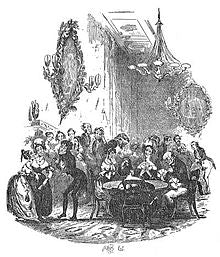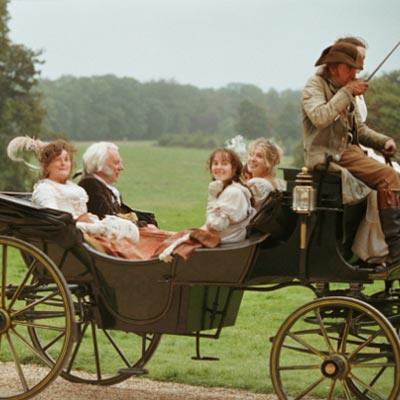Miss Thorpe, however, being four years older than Miss Morland, and at least four years better informed, had a very decided advantage in discussing such points; she could compare the balls of Bath with those of Tunbridge, its fashions with the fashions of London; could rectify the opinions of her new friend in many articles of tasteful attire; could discover a flirtation between any gentleman and lady who only smiled on each other; and point out a quiz through the thickness of a crowd.
Northanger Abbey
Eyeglasses as we know them today, with side pieces that rest on the ears, were invented in 1727 by an Englishman named Edward Scarlett. Until that time, reading aids were often perched precariously upon the nose or were hand held. A "
quizzing glass" was a single magnifying lens on a handle which was held up before the eye to enable closer scrutiny of the object in view. The quizzing glass is not to be confused with the lorgnette, which has two lenses, and more often than not a correctable (prescription) lens rather than a simple magnifier. A monocle is also a single-lens device but is meant to fit into the eye socket and therefore does not have the longer handle of the quizzing glass, which was held in front of the eye.

The earlist examples of single-lens hand-held reading devices date back to the 12th century and were simple affairs with bone or brass handles used by scholars and clerks. It was not until the mid-18th century that they developed into a fashionable accessory, designed and worn as a piece of jewelery. (See Fig. 1) The quizzing glass generally dangled at the end of a long ribbon or chain around the neck and was held up to the eye to "quiz" (stare, glance, look at quizically) people and objects. The wearer would sometimes glare at a person through his or her quizzing glass as a manner of set-down or mockery, as seen in the detail from Vernet's "Les Deux Incroyables" shown in Fig. 2.
The term "quizzing glass" came into use toward the end of the 18th century. It is sometimes assumed that quizzing glasses were used only by men as they are most often associated with fashionable dandies of the Regency and Victorian eras, such as "The Exquisite" shown in Fig 2. However, the fashion prints of the Regency show ladies wielding them with as much aplomb as Beau Brummel. And those ladies are not the elderly dowagers one might imagine using such a device, but fashionable young women. In fact, the quizzing glass is such a common feature in fashion prints that it must be assumed that it was an extremely popular accessory. Most prints and portraits of women wearing quizzing glasses show them on a long gold chain around the neck. Men are frequently shown with a quizzing glass on a black ribbon, though gold chains are also used.
A quizzing glass was as much a piece of jewelry as it was a functional vision aid. They were made of gold, sterling, pinchbeck, and other base metals, and were sometimes quite elaborate in design. The handles might be jeweled, or hold secret vinaigrettes or lockets (see Fig 3). The handle or its loop was often swivel-mounted to make it easier to lay flat when hung from a chain. Though the lenses were generally standard sizes, the handles were of varying lengths. (See Fig 4) Of course, the longer the handle, the more delicious the set-down.

Quizzing glasses were almost always set with a magnifying lens, though some may have been set with a corrective lens since fashionable ladies and gentleman did not like to wear spectacles in public. Quizzing glasses were obtained from opticians and were usually kept in protective leather cases. (See fig 5) It is likely that the opticians set the lens in frames provided by goldsmiths or jewelers.
Quizzing glasses reached a peak of popularity during the first two decades of the 19th century. Around the 1830s, lorgnettes became more popular for women. Quizzing glasses continued as a fashionable accessory for gentlemen through the beginning of the 20th century when monocles supplanted them in popularity.
 Candice Hern is the author of several Regency Romance novels and an avid collector of period fashion accessories. Her newest book is Lady Be Bad, part of her 'Merry Widows' series
Candice Hern is the author of several Regency Romance novels and an avid collector of period fashion accessories. Her newest book is Lady Be Bad, part of her 'Merry Widows' series
 The earlist examples of single-lens hand-held reading devices date back to the 12th century and were simple affairs with bone or brass handles used by scholars and clerks. It was not until the mid-18th century that they developed into a fashionable accessory, designed and worn as a piece of jewelery. (See Fig. 1) The quizzing glass generally dangled at the end of a long ribbon or chain around the neck and was held up to the eye to "quiz" (stare, glance, look at quizically) people and objects. The wearer would sometimes glare at a person through his or her quizzing glass as a manner of set-down or mockery, as seen in the detail from Vernet's "Les Deux Incroyables" shown in Fig. 2.
The term "quizzing glass" came into use toward the end of the 18th century. It is sometimes assumed that quizzing glasses were used only by men as they are most often associated with fashionable dandies of the Regency and Victorian eras, such as "The Exquisite" shown in Fig 2. However, the fashion prints of the Regency show ladies wielding them with as much aplomb as Beau Brummel. And those ladies are not the elderly dowagers one might imagine using such a device, but fashionable young women. In fact, the quizzing glass is such a common feature in fashion prints that it must be assumed that it was an extremely popular accessory. Most prints and portraits of women wearing quizzing glasses show them on a long gold chain around the neck. Men are frequently shown with a quizzing glass on a black ribbon, though gold chains are also used.
A quizzing glass was as much a piece of jewelry as it was a functional vision aid. They were made of gold, sterling, pinchbeck, and other base metals, and were sometimes quite elaborate in design. The handles might be jeweled, or hold secret vinaigrettes or lockets (see Fig 3). The handle or its loop was often swivel-mounted to make it easier to lay flat when hung from a chain. Though the lenses were generally standard sizes, the handles were of varying lengths. (See Fig 4) Of course, the longer the handle, the more delicious the set-down.
The earlist examples of single-lens hand-held reading devices date back to the 12th century and were simple affairs with bone or brass handles used by scholars and clerks. It was not until the mid-18th century that they developed into a fashionable accessory, designed and worn as a piece of jewelery. (See Fig. 1) The quizzing glass generally dangled at the end of a long ribbon or chain around the neck and was held up to the eye to "quiz" (stare, glance, look at quizically) people and objects. The wearer would sometimes glare at a person through his or her quizzing glass as a manner of set-down or mockery, as seen in the detail from Vernet's "Les Deux Incroyables" shown in Fig. 2.
The term "quizzing glass" came into use toward the end of the 18th century. It is sometimes assumed that quizzing glasses were used only by men as they are most often associated with fashionable dandies of the Regency and Victorian eras, such as "The Exquisite" shown in Fig 2. However, the fashion prints of the Regency show ladies wielding them with as much aplomb as Beau Brummel. And those ladies are not the elderly dowagers one might imagine using such a device, but fashionable young women. In fact, the quizzing glass is such a common feature in fashion prints that it must be assumed that it was an extremely popular accessory. Most prints and portraits of women wearing quizzing glasses show them on a long gold chain around the neck. Men are frequently shown with a quizzing glass on a black ribbon, though gold chains are also used.
A quizzing glass was as much a piece of jewelry as it was a functional vision aid. They were made of gold, sterling, pinchbeck, and other base metals, and were sometimes quite elaborate in design. The handles might be jeweled, or hold secret vinaigrettes or lockets (see Fig 3). The handle or its loop was often swivel-mounted to make it easier to lay flat when hung from a chain. Though the lenses were generally standard sizes, the handles were of varying lengths. (See Fig 4) Of course, the longer the handle, the more delicious the set-down.
 Quizzing glasses were almost always set with a magnifying lens, though some may have been set with a corrective lens since fashionable ladies and gentleman did not like to wear spectacles in public. Quizzing glasses were obtained from opticians and were usually kept in protective leather cases. (See fig 5) It is likely that the opticians set the lens in frames provided by goldsmiths or jewelers.
Quizzing glasses reached a peak of popularity during the first two decades of the 19th century. Around the 1830s, lorgnettes became more popular for women. Quizzing glasses continued as a fashionable accessory for gentlemen through the beginning of the 20th century when monocles supplanted them in popularity.
Quizzing glasses were almost always set with a magnifying lens, though some may have been set with a corrective lens since fashionable ladies and gentleman did not like to wear spectacles in public. Quizzing glasses were obtained from opticians and were usually kept in protective leather cases. (See fig 5) It is likely that the opticians set the lens in frames provided by goldsmiths or jewelers.
Quizzing glasses reached a peak of popularity during the first two decades of the 19th century. Around the 1830s, lorgnettes became more popular for women. Quizzing glasses continued as a fashionable accessory for gentlemen through the beginning of the 20th century when monocles supplanted them in popularity.
Candice Hern is the author of several Regency Romance novels and an avid collector of period fashion accessories. Her newest book is Lady Be Bad, part of her 'Merry Widows' series


